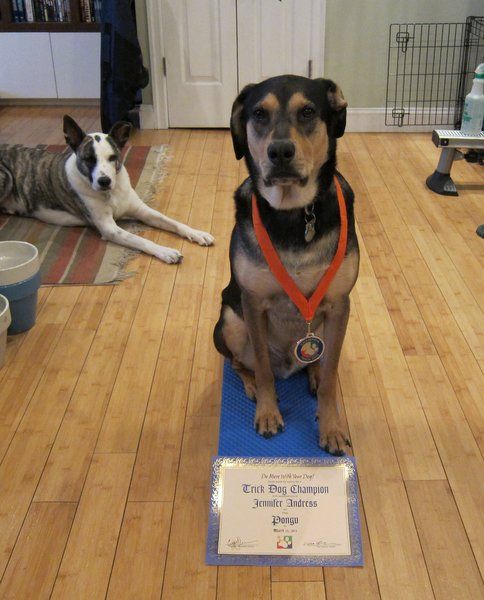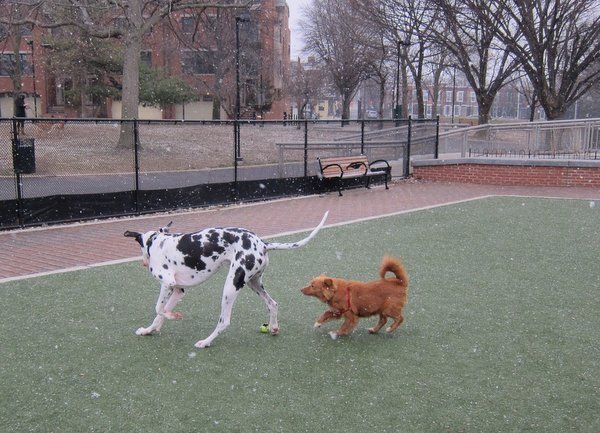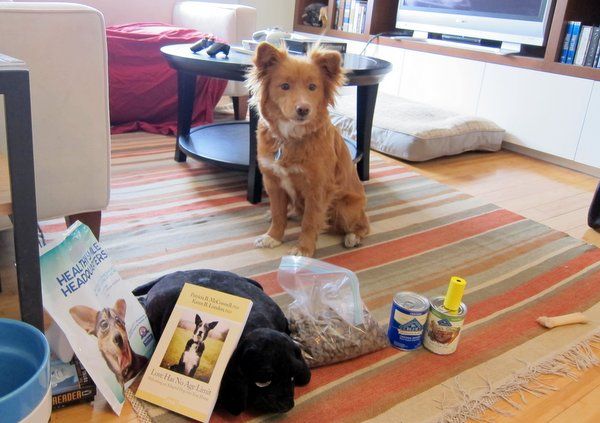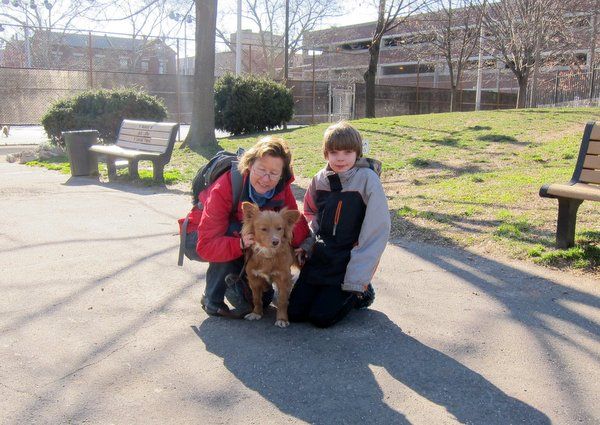It's a lot of fun. I can hide the eggs in fairly difficult ways now (under a cloth, raised up on platforms, cardboard boxes, or chair seats, stuffed inside socks, tucked under noise-making obstacles like squeaky snake, etc.) and he enjoys the challenge of sniffing out the eggs and plunking them into the basket. I imagine we'll be playing a lot of this game on rainy days long after Easter's gone, and I'll be looking for even tricksier ways to hide those eggs.
As part of the project (since, as far as I know, this is a trick of my own invention -- I wouldn't be surprised if someone else did it first, but I didn't know about it), I recorded each step of how we learned this game, in case anyone else wanted to do this with their dogs and wasn't sure how to teach it. It really is a lot of fun, and not that hard to train. For Pongu it took about three weeks, but (a) he was starting from zero with regard to retrieving objects; and (b) we were/are training a lot of other new things more intensively at the same time that we were practicing this trick. So if your dog is already familiar with the retrieve concept and/or you don't have anything else on your plate, you're already ahead.
Step 1: Beginning Directed Drop
We didn't start out with Easter eggs. We started with a soft, squishy ball (pretty sure this is one that Dog Mob ripped out of a Kong Wubba and then deflated). Hard plastic Easter eggs are slippery and difficult for a dog to manage without dropping or breaking them open. In the beginning, I wanted Pongu to get comfortable with the novel concept of picking up an object and dropping it into a designated receptacle instead of bringing it to me. To avoid distracting him with other considerations, we used the easiest possible object for him to manage -- this poor, hard-used, deformed squishy ball.
The "basket" is also designed to be as easy as possible. I used the broadest, shallowest, most easily accessible container we had. I covered it with a cloth partly to muffle sound (Pongu is acutely sound sensitive and I was worried the "thunk" of a ball falling into the container would be aversive) and partly so that I could later use the cloth as a visual marker to transfer from this container to an Easter basket. I figured that if he was familiar with targeting the cloth, he might have an easier time carrying the behavior over to a slightly different context.
At this point, Pongu earns a click for carrying the ball in the direction of the basket and dropping it anywhere in its vicinity (defined by the mat), and a jackpot if he actually gets the ball inside the container.
Step 2: Introducing Easter Eggs and Multiple Drops
Once Pongu was reasonably adept with manipulating the ball, and seemed to understand the goal behavior, I switched from the squishy ball to the plastic Easter eggs he'd be using in the final version. This was actually a sub-step in itself, because initially he was not into those eggs.
But he eventually got more comfortable with them (at this point he was still breaking and dropping them a lot, but he'd carry them) and we started practicing with the eggs. I also raised the criteria on the receptacle drop: he had to collect multiple eggs before getting a treat, and I switched the container to a deeper and smaller-mouthed one that was closer to the dimensions of the Easter basket we were going to use.
At this step we weren't really adding any new behaviors, just refining and raising difficulty from the first step.
Step 3: Basket and Basic Find
The next stage was to replace the open-topped container with an Easter basket. Because the basket has a handle across the top, it's much more difficult for the dog to drop an egg inside -- he can't just stick his head directly over the basket and drop it straight in, but has to calculate an angled approach.
I also introduced a very simple "find" component to the game at this stage. Instead of having the eggs lying totally out in the open, they are (just barely) concealed. One is partly under a sock, the other is raised up about ten inches on a platform. They aren't hidden very well, but the concept's introduced: you're gonna have to start looking for these eggs soon, buddy.
Step 4: Introducing Basket Carry
At the end of this trick, I wanted Pongu to bring me the basket full of eggs, so we had to introduce that behavior as well. He got a click and treat first for doing a nose touch to the basket handle, then for mouthing it, and finally for picking it up and moving it even the tiniest fraction of an inch.
I wrapped a white cloth around the basket handle because we were using cheapie $1.99 Chinese-made baskets from the corner drugstore, and god only knows what kinds of toxic dyes they use for those things. I don't want my dog dying of mouth cancer, so I wrapped up the handle -- which had the added benefit of giving him an easier grip on the thing.
Nonetheless, the basket was extremely unwieldy, partly because of its weight distribution and partly because this particular basket has such a long handle that Pongu just couldn't get it high enough off the ground to avoid bumping the bottom. After a couple of sessions I bought a new, smaller basket. It made the egg drop more difficult, but he could carry the thing a little more easily.
Step 5: Putting It All Together
After a couple of weeks, Pongu had all the basic pieces in place: finding the eggs, carrying them to the basket, going back for more eggs, and bringing me the basket at the end of his collection. We spent a few days practicing so that he could build up fluency in each component behavior and become more familiar with the pattern. (Part of the end goal was to have a game that sounded conversational and didn't rely on formal cues -- or, better yet, worked as a single behavior chain on one cue -- so I didn't want to be constantly barking out "Find!" and "Basket!" as he worked.)
At this stage, all the eggs are moderately hidden, we're raising the total number of eggs, and I'm asking him to bring me the basket at the end. It's not 100% to final form, but by this point it was just a matter of practice.
And that's how I taught my dog to hunt Easter eggs.






















